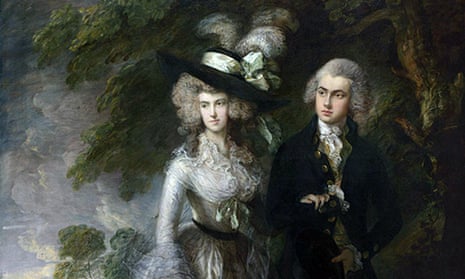A wing of the National Gallery was evacuated on Saturday afternoon after a man attacked a Thomas Gainsborough painting with a screwdriver.
At about 2.15pm in the east wing of the gallery, a visitor attacked the 1785 painting Mr and Mrs William Hallett, better known as The Morning Walk. Gallery assistants and visitors detained the man, who was then arrested.
The wing was evacuated and off-limits for about two hours. On Sunday afternoon police announced they had charged Keith Gregory, 63, of no fixed abode, with causing criminal damage. He has been remanded to appear at Westminster magistrates court on Monday.
“The damage is limited to two long scratches which have penetrated the paint layers but not the supporting canvas,” a spokeswoman for the gallery said. “The painting was removed from display and examined by the gallery’s conservators, who are now assessing next steps.”
The Morning Walk hangs in room 34, which houses British paintings and was used as the setting for a covert meeting between Daniel Craig’s James Bond and Ben Whishaw’s equipment expert Q in the film Skyfall.
The Gainsborough painting can be spotted over Craig’s shoulder as the pair admire a painting by Joseph Turner, The Fighting Temeraire, and discuss the high-tech weaponry Q has prepared for Bond. Turner’s painting depicts a warship that had fought in the Battle of Trafalgar being towed away to be broken up.
Mark Bills, director of Gainsborough’s House, the museum in the artist’s former home in Sudbury, Suffolk, told the Guardian the attack was “quite shocking ... We all prepare for it in museums but it’s quite unusual.”
He was confused as to why this painting was attacked. “It’s a picture that I can’t imagine anybody finding offensive – what an odd thing to want to do,” he said.
Gainsborough is among Britain’s most famous artists and was one of the original members of the Royal Academy. Initially a painter of landscapes, he turned to portraits because they paid more.
The Morning Walk was commissioned when Gainsborough was at the pinnacle of his fame, a couple of years after commissions from King George III and the Queen in 1781.
Bills said: “It’s one of his great masterpieces: he was absolutely at the height of his powers ... When we think about Gainsborough, it’s usually from around these years. When you think of the elegant portraits of the Georgian period, that’s the one that comes to mind.”

Painted three years before the artist’s death, it depicts a young couple, William Hallett and Elizabeth Stephen, walking in the countryside accompanied by a dog. They were both 21 when the painting was started and were due to be married in the summer of 1785. Some art historians believe Elizabeth is painted wearing her wedding dress.
The painting, in the British romantic style, captures the 18th-century trend for society portraits to be set in informal, pastoral settings – although at over two metres tall, it is on a grand scale – and the couple are dressed in all their finery. The gallery’s catalogue notes the “light, feathery brushstrokes used to describe the landscape” and the way William’s hair and Elizabeth’s shawl almost blend into the landscape.
The painting demonstrates the “economy of brushstrokes” Gainsborough developed in his later years, when he would use a longer brush to ensure freer strokes, Bills said. “By this stage, he was such a confident painter he could capture that moment. It takes a lifetime of experience to do that,” he said.
The fact that the canvas was not torn in the screwdriver attack gave Bills hope the painting could be fully repaired. “It’s amazing what conservators can do,” he said. “You probably won’t see a difference ... I’m relieved from what I’ve read it hasn’t caused any permanent damage.”
The National Gallery has owned the painting for more than 60 years. It was bought in 1954 for £30,000 – about £770,000 in today’s money – from Lord Rothschild, using a £5,000 contribution from the Art Fund.
The highest price paid for a Gainsborough painting was £6.5m for Portrait of Miss Read, Later Mrs William Villebois, in 2011 at an auction at Christie’s in London.
Art attacks
Previous artworks that have been vandalised include:
Black on Maroon, Mark Rothko
A £5m abstract mural by the US artist was defaced in the Tate Modern by a Polish man, Wlodzimierz Umaniec, who wrote in a corner of the painting. He said it was an act of “yellowism”, committed to engage with modern art. He was jailed for two years.
Fountain, Marcel Duchamp
A version of Duchamp’s porcelain urinal, considered a key work of early modern art, was attacked with a hammer at the Pompidou Centre in Paris in 2006. The culprit, 77-year-old Pierre Pinoncelli, said the attack was a work of performance art. A judge disagreed and fined him €214,000 (£147,000). Pinoncelli had previously urinated on another version of Fountain.
Rokeby Venus, Velazquez
Suffragette Mary Richardson attacked the nude portrait with a meat cleaver at the National Gallery in 1914, causing seven cuts to the canvas. She said it was an act of protest over the arrest the previous day of Emmeline Pankhurst.
Mona Lisa, Leonardo da Vinci
Leonardo’s portrait was attacked at the Louvre in Paris twice in one year in 1956: first, it had acid thrown at it, and then an unnamed Bolivian threw a rock at it, chipping the paint on Mona Lisa’s left elbow. In 2009 the painting – now shielded behind bulletproof glass – had a mug thrown at it by a Russian woman.
